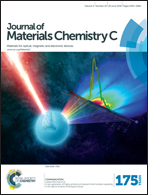Growth and characterization of Cr doped SnO2 microtubes with resonant cavity modes
Abstract
Cr doped SnO2 microtubes have been fabricated by a thermal evaporation–deposition method. The microtubes are formed by {110} lateral faces and their growth direction is [001], as determined by different crystallographic techniques. Chromium is homogeneously distributed along the tubes at a concentration of around 1 at%, as estimated by energy dispersive X-ray spectroscopy (EDS), as well as X-ray absorption spectroscopy (XAS) and X-ray fluorescence (XRF) in a synchrotron line. The optical properties of the microtubes can be modulated by Cr doping, and as an example the Cr doped tubes show purplish coloring, in contrast to the transparent undoped ones. Moreover Cr doping induces a drastic change in the luminescence of the microstructures, as analyzed by cathodoluminescence (CL) and photoluminescence (PL) techniques. The wide luminescence in the visible range, characteristic of undoped SnO2, changes into dominant near-infrared luminescence at 1.4 eV, the origin of which is discussed in this work. The presence of luminescence emission peaks at around 1.79 eV confirms that Cr3+ has been incorporated in the microtubes and behaves as optically active. The analysis of the resonance peaks observed in the near-infrared region in the PL spectra indicates the presence of Fabry–Perot optical cavity modes across the lateral faces of the tubes. A refractive index of 1.97 ± 0.20 has been estimated for Cr doped SnO2. Enhanced IR active modes in the Cr doped tubes have been observed by Raman spectroscopy. The presence of Cr induces variations in the electronic structure of SnO2, as analyzed by photoemission spectroscopy.


 Please wait while we load your content...
Please wait while we load your content...